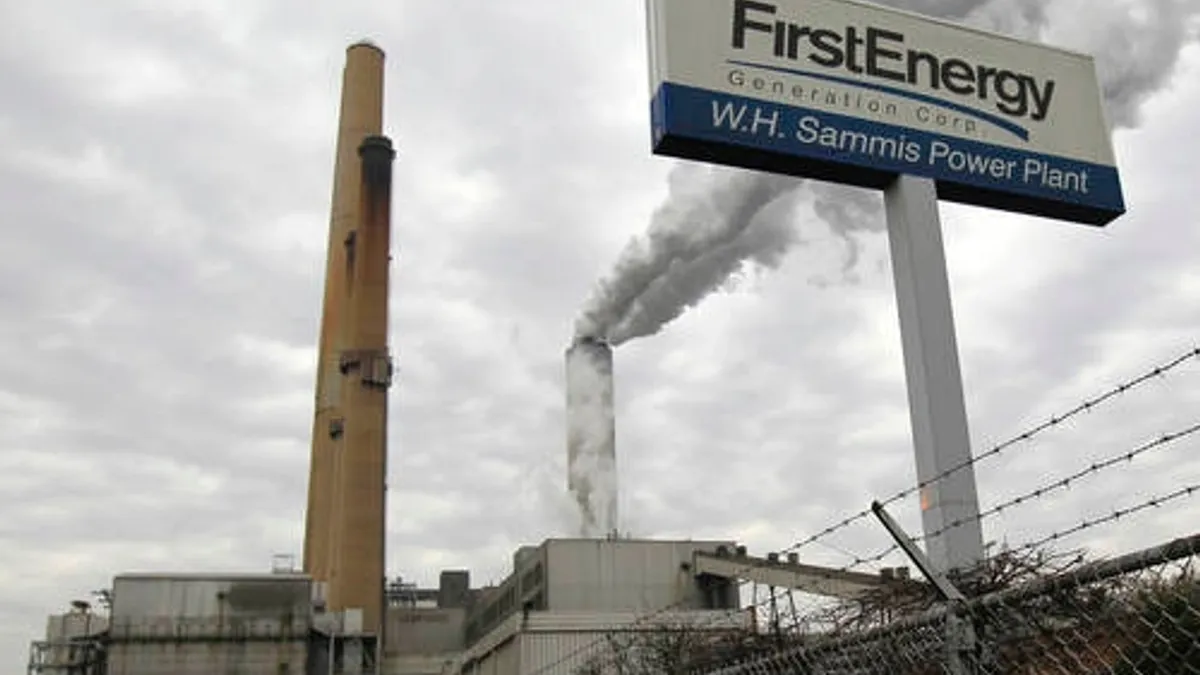Dive Brief:
- FirstEnergy Corp.'s competitive generation subsidiary FirstEnergy Solutions filed for Chapter 11 bankruptcy protection on Saturday, a widely-anticipated move in the parent company's quest to transform itself into a fully-regulated utility company.
- The filing includes FirstEnergy Solutions, all FES subsidiaries and FirstEnergy Nuclear Operating Co. but does not involve FirstEnergy or its distribution, transmission, regulated generation and Allegheny Energy Supply subsidiaries. The move comes after FES asked the U.S. Department of Energy to issue an emergency order to provide cost recovery to coal and nuclear plants in the PJM Interconnection market, saying market conditions threaten reliability. The company also announced that same week it would retire three nuclear facilities over a three-year span.
- FirstEnergy CEO Chuck Jones in a February earnings call previewed the company's merchant generation bankruptcy, indicating that a final loan to the subsidiary would likely be the last business connection between the two.
Dive Insight:
The bankruptcy has been widely anticipated, as FirstEnergy has struggled to make money from coal and nuclear plants. The company has long signaled its intention to become a fully regulated utility company, which Jones said "should give FirstEnergy a stronger balance sheet, solid cash flows and more predictable earnings."
Unsecured creditors are owed billions by FES and six affiliated debtors who filed this weekend, with the Bank of New York Mellon Trust Co NA likely the largest unsecured creditor. The list of 50-largest unsecured debts includes more than $2 billion owed to NY Mellon Trust, along with two unsecured claims in litigation with BNSF Railway and Norfolk Southern Corp., transportation companies which move coal supplies.
Wilmington Savings Fund Society is owed $769 million, the largest single known debt, for "claims related to sale-leaseback transaction."
Companies named as debtors include: FirstEnergy Solutions; FE Aircraft Leasing Corp.; FirstEnergy Nuclear Generation; FirstEnergy Nuclear Operating Co.; FirstEnergy Generation LLC; FirstEnergy Generation Mansfield Unit 1 Corp.; and Norton Energy Storage LLC.
FirstEnergy officials in a statement stressed that the filing did not include regulated utility subsidiaries and that the move would have no impact on customers.
The company's filing comes just days after it announced three nuclear plants would close, and it asked the federal government to intervene in PJM to keep them operating. The company made the appeal under Section 202(c) of the Federal Power Act, which allows the DOE to issue emergency orders to keep plants operating. However, Section 202(c) orders are infrequent and typically are issued in response to natural disasters.
FirstEnergy Solutions also notified PJM and the U.S. Nuclear Regulatory Commission that two nuclear plants in Ohio and one in Pennsylvania, with combined capacity of 4 GW, would be deactivated over the next three years. The closures will include the 908 MW Davis-Besse Nuclear Power Station in Ohio; the 1,872 MW Beaver Valley plant in Pennsylvania and the 1,268 MW Perry Nuclear plant in Ohio. In January, FirstEnergy warned Davis-Besse would close if Ohio lawmakers did not approve a plant subsidy bill.
In 2016, FirstEnergy announced that it would explore strategic alternatives for its commodity-exposed generation business, with a goal of exiting the business by mid-2018. The company's regulated generation fleet totals about 3.8 GW and includes four plants in West Virginia, Virginia and New Jersey.















